2022-2023 年浙江温州高一英语下学期期末试卷及答案
第一部分 听力(共两节,满分 30 分)
第一节(共 5 小题;每小题 1.5 分,满分 7.5 分)
听下面 5 段对话。每段对话后有一个小题,从题中所给的 A、B、C 三个选项中选出最佳选
项。听完每段对话后,你都有 10 秒钟的时间来回答有关小题和阅读下一小题。每段对话仅
读一遍。
1. What class is the man going to take?
A. Chinese. B. Physics. C. History.
2. Where does this conversation probably take place?
A. In a shop. B. In the street. C. In the post office.
3. Why does the man come to Kathy’s home?
A. To play the piano. B. To pick her up. C. To return a book.
4. What are the speakers mainly talking about?
A. Food. B. A trip. C. Buildings.
5. What is the woman going to do tomorrow?
A. Go fishing. B. Do some shopping. C. Visit a gallery.
第二节(共 15 小题;每小题 1.5 分,满分 22.5 分)
听下面 5 段对话或独白。每段对话或独白后有几个小题,从题中所给的 A、B、C 三个选项
中选出最佳选项。听每段对话或独白前,你将有时间阅读各个小题,每小题 5 秒钟;听完后,
各小题将给出 5 秒钟的作答时间。每段对话或独白读两遍。
听第 6 段材料,回答第 6、7 题。
6. What has probably caused the woman’s strange feeling recently?
A. Sitting too long. B. Lifting heavy things. C. Holding her child.
7. What is the probable relationship between the speakers?
A. Doctor and patient. B. Husband and wife. C. Neighbours.
听第 7 段材料,回答第 8 至 10 题。
8. What is the man?
A. A farmer. B. A shop owner. C. A supermarket manager.
9. What is special about the man’s vegetables?
A. They are fresh. B. They are imported. C. They are home-grown.
10. What will the woman do next?
A. Join a group chat. B. Bargain with the man. C. Make a shopping list.
听第 8 段材料,回答第 11 至 13 题。
11. Why did William buy a new house?
A. The house is larger.
B. The decoration is beautiful.
C. The neighbourhood is popular.
12. When was the new house put on the market?
A. Last month. B. Last year. C. Six years ago.
13. Who will fix the roof?
A. House builders. B. The former owner. C. William and his father.
�
听第 9 段材料,回答第 14 至 17 题。
14. What’s wrong with the woman’s computer? C. It can’t run fast.
A. It can’t be charged. B. It can’t be started.
15. How long has the woman used the computer?
A. Around two years. B. Around four years. C. Around six years.
16. What will the man do with the computer?
A. Fix the system.
B. Change the hard drive.
C. Download modem software.
17. What does the man think of the computer after the repair?
A. It will be like a new one.
B. It can still work for years.
C. It may break down again.
听第 10 段材料,回答第 18 至 20 题。
18. How does the speaker usually find summer jobs?
A. From stores. B. From friends. C. From websites.
19. Why are there fewer students doing summer jobs according to the speaker?
A. Students focus more on study.
B. Students don’t like job training.
C. Students prefer going on vacation.
20. What’s the purpose of the speech?
A. To train young employees.
B. To advise taking summer jobs.
C. To recommend some summer jobs.
第二部分 阅读(共两节,满分 50 分)
第一节(共 15 小题;每小题 2.5 分,满分 37.5 分)
阅读下列短文,从每题所给的 A、B、C、D 四个选项中,选出最佳选项。
Here’s a list of the new picture books and novels for children and teens this
A
month.
Food Fight by Alex Latimer, Oxford, £7.99
The Fruits and the Vegetables are long-standing enemies until secret friends
Grape and Mushroom set off on a pilgrimage (朝圣) to the Wise d Cheese. Can they
find a way bring peace to Fruit Bowl and Veg Drawer alike? A diversity of verbal
and visual puns (双关语) makes for a funny picture-book treat.
The Boy Who Saved a Bear by Nizrana Farook, Nosy Crow, £7.99
Farook’s latest animal adventure features a boy Numan who is convinced that
his parents favour his perfect brother Krish and is determined to prove his worth.
After he takes over Krish’s book delivery job, he forms an unexpected bond with
a frightening bear and sets out to return the stolen Key of Nissanka to the King’
s City. This lively, exciting picture book for 8+ will attract existing fans and
newcomers alike.
Stink by Jenny McLachian, Farshore, £7.99
Danny thinks the fairy door he got for his birthday is a rubbish present. Worse
�
still, Stink, the world’s worst fairy, flies out of it. Stink does nothing but ride
on rats, eat insects and cause trouble. The only way she can get back to Fairyland
is by doing a good deed. Can Danny help his hopeless fairy be good for once? This
wildly comic, highly illustrated book is perfect for 6 and up.
A Child Like You by Na’ima B Robert and Nadine Kaadan, Otter-Barry, £12.99
This powerful picture book for 5+ readers describes four children’s fears and
worries — climate disaster, lack of support, feeling lost and alone — and then
shows how they find ways to fight back, “because the world can be a hopeful place”
too.
1. Which book suits kids interested in animal stories?
A. Food Fight.
C. Stink.
2. What virtue may the book Stink reflect?
A. Patience.
work.
3. What do the four books have in common?
A. They have illustrations.
C. They are real-life stories.
【答案】1. B
B. They center on friendship.
D. They are for readers of all ages.
B. The Boy Who Saved a Bear.
D. A Child Like You.
2. C
3. A
B. Honesty.
C. Kindness.
D. Hard
B
On our second day in Barcelona, Spain, my classmates and I headed out to see
the sights. We hadn’t had a chance to stop by any banks to take out cash, but we
had our bank cards, which, to our American way of thinking, would naturally be
accepted anywhere. Our teacher led us to La Sagrada Familia, a church which has been
under construction for over 100 years.
She let each of us decide whether we wanted to pay for entrance to the church
or return to the hotel after a long day. Many headed for the subway and returned
to the hotel. Eager to explore more, two of my friends and I wandered about the plaza
(露天广场), but soon the other two decided they wanted to return to the hotel also.
I was confident in my abilities and had a subway ticket, so I felt comfortable without
them; I got in line to enter the church.
When I reached the window, they asked for the 10-euro admission price. I
confidently handed over my bank card, which they denied, asking for cash only. I
was shocked. I only had three euros on hand, and my entire group had left. I was
leaving the next day to fly to Madrid, and I wasn’t going to get this opportunity
again.
Just then, I overheard English being spoken around me. It took about ten minutes
to collect my courage to approach the speakers and explained my dilemma: American
student, no cash, priceless landmark, no other opportunity to see it. Fortunately,
one smiling woman handed me a 20-euro bill. “Go buy me a bottle of wine, and you
can keep the change,” she offered. I did so without delay, grateful that I wouldn’
t miss this fantastic opportunity.
Perhaps seven euros didn’t mean a lot to her, but it meant a lot to me, and
she offered it in such a friendly way that I didn’t feel like a beggar. That simple
�
B. His ability to travel alone.
D. His teacher’s encouragement.
act of kindness remains in my memory as one of the nicest things a stranger has ever
done for me.
4. What made the author decide to visit the church?
A. His friends’ company.
C. His interest in the church.
5. Why was the author unable to enter the church?
A. He lacked enough cash.
C. The ticket was too expensive.
unfriendly.
6. Which of the following best describes the woman’s behavior?
A. Thoughtful.
Powerful.
7. What is the purpose of the text?
A. To suggest a travel destination.
C. To show the cultural differences.
abroad.
【答案】4. B
B. To share a heart-warming story.
D. To give advice on travelling
B. He couldn’t speak Spanish.
D. The ticket sellers were
5. A
6. A
7. B
B. Effortless.
C. Selfless.
D.
C
Earlier this month, TikTok announced that it will be introducing screen time
limits for the accounts of users aged under 18. Children under 13 will require a
parent or guardian to type in a password to continue scrolling (滚屏) through their
feed, and those aged 13-17 will be asked to set their own passwords when the viewing
time goes beyond the limit.
Studies suggest that 30 minutes may be the sweet spot for social media use, where
users are able to stay connected with friends and family and view entertainment.
However, many other studies show that overly-heavy social media use can lead to a
lot of problems, such as physical issues and depression.
By suggesting 100 minutes as a hard line where a password is required to be
created by the user, TikTok is gradually making the standards clear as to what may
be regarded as problematic social media habit in young people. Although these
passwords for older teenagers can obviously be bypassed, they are a step in the right
direction in encouraging children to use social media responsibly.
Also, parents who own their own TikTok accounts will be able to link with their
children’s accounts, gaining additional, such as muting notifications (消息免打
扰) and customizing time limits for different days in the week.
Algorithms (算法) that could tell parents if the child has been viewing dangerous
material could soon be put into use. However, the difficulty in this is the amount
of content available on the internet.
Ultimately, apps such as TikTok and Instagram will need to continue introducing
more measures to improve online safety for children.
Lawmakers around the world are paying close attention to the effect social media
has on the young, meaning that the development of new tools to improve its use will
no doubt take place soon if big tech wishes to avoid additional legal issues.
�
B. Objective.
C. Concerned.
8. Why did TikTok introduce screen time limits for teenagers?
A. To protect their privacy.
B. To develop their self-control.
C. To improve family relationship.
D. To prevent overuse of social media.
9. What’s the author’s attitude towards TikTok’s new policy?
A. Favourable.
Disapproving.
10. What can parents do to help children use social media responsibly?
A. Type in a password to stop the use.
B. Send a link to the children’s account.
C. Set time limits through their own account.
D. Use algorithms to remove dangerous content.
11. What does the last paragraph mainly talk about concerning social media?
A. Its effects on the young.
improvement.
C. Its application to lawmaking.
issues.
【答案】8. D
B. Legal pressure on its
D.
D. Solutions to its technological
9. A
10. C
11. B
D
It’s hard to predict which songs will become hits. It’s even more difficult
to predict which artists topping today’s charts will go on to record more hits and
who will see their fame end.
To figure out if there’s some kind of principle that can help explain who becomes
a flash in the pan and who has a lasting music career, Justin Berg, a social scientist
who researches creativity at Stanford University’s business school, studied the
songs from pop music charts. He used a database of about 3 million songs from
1959-2010 released by record labels that had produced at least one hit in the United
States over that time. Of those songs, nearly 25,000 landed on the weekly Billboard
Hot 100. That provided Berg with a list of nearly 4,900 artists who had one or more
songs that made the list, his yardstick (标准) for defining a hit.
Hits are rare, the data show. Of the 69,000 artists in the original database,
93 percent never had a hit, 3 percent had one and 1 percent had two hits. The success
rate for additional hits drops from there.
Artists with more variety in their music type have a better chance to land repeat
hits. But there’s a dilemma for artists who want to be popular over the long term.
Variety isn’t what helps artists land that first hit, Berg reports. It’s the
similarity of a new song to recent hits.
According to Berg’s study, musical artists who produced music like other already
existing music were about twice as likely to have their first hit. But those who
created a more creative and varied music type before fame hit were more likely to
make a series of hits.
However, Berg doesn’t want his research to diminish (贬低) the accomplishments
�
B. A short-lived success.
D. A quick-minded talent.
of one-hit wonders. “A lot of them in their time were quite famous and successful,”
he says. “You go out and try to make a song that catchy. It’s not an easy challenge.”
12. What does the underlined phrase “a flash in the pan” mean in Paragraph 2?
A. A rising star.
C. An unpopular topic.
13. What can we learn from the study?
A. It’s common for artists to have more than one hit.
B. Creative artists are more likely to make their first hit.
C. People prefer the existing music type to the creative one.
D. Both similarity and variety are important to artists’ success.
14. What does Justin Berg say about one-hit wonders?
A. Their success cannot be repeated.
B. Their life wasn’t easy in their time.
C. Their success deserves recognition.
D. They were good at making catchy songs.
15. What is a suitable title for the text?
A. What will hits be like in the future?
B. How do artists make a series of hits?
C. What does it take to be a successful artist?
D. Why is it hard to have a lasting music career?
【答案】12. B
第二节(共 5 小题;每小题 2.5 分,满分 12.5 分)
阅读下面短文,从短文后的选项中选出可以填入空白处的最佳选项,选项中有两项为多余
选项。
15. C
13. D
14. C
Every day, we face a series of opportunities to do the right thing. Sometimes
we seize(抓住) those moments; other times, we don’t. ____16____ And what drives
some people to take the moral high ground?
Jessie Sun interviewed 952 people about the motivations(动机) for moral behavior
and the changes they wished to make in their lives in order to become more morally
good.
When we think about morals, we often think about making “personal sacrifices(牺
牲)” for the greater good. In Sun’s study, she found that nearly half of the
participants said they were most encouraged to become more moral for themselves.
____17____ And fewer participants said that they most wanted to benefit friends and
people in general.
Moreover, many people believe that acting more morally—for example, being more
thoughtful, more open-minded—would increase their own well-being. The more they
believed that their moral change would have positive results for themselves, the
more they reported being encouraged to make that change. ____18____ That was the
most surprising finding in the study.
____19____ Interestingly, participants generally expected possible harms to
themselves and others if they were honest. You can imagine that some people regularly
tell white lies to save other people’s feelings, and they believe it would be hurtful
if they were honest.
�
Researchers also asked people about the things they’d like to improve about
themselves. If they’re extremely shy, they usually want to become more comfortable
in social situations. But if they aren’t especially honest or thoughtful, they
usually won’t improve those aspects of their lives on purpose. ____20____
A. How can we become more moral?
B. So, why do we make these choices?
C. Being moral just isn’t what most people consider first.
D. Being moral means different things to different people.
E. But people see some disadvantages of being moral, too.
F. In short, many people want to become more moral for their own benefits.
G. Sixteen percent said that they most wanted to become more moral for their family.
【答案】16. B
第三部分 语言运用(共两节,满分 30 分)
第一节(共 15 小题;每小题 1 分,满分 15 分)
阅读下面短文,从每题所给的 A、B、C、D 四个选项中,选出可以填入空白处的最佳选项。
Nina had always felt like she was living in the shadows. Growing up, she was
the shy kid who always sat in the back of the classroom and ____21____ spoke up.
She had a few friends, but they were also quiet, so they never really did anything
____22____. As she got older, she wanted to break out of her shell and experience
new things. However, she didn’t know ____23____.
19. E
20. C
17. G
18. F
One day, Nina ____24____ a group of people playing Frisbee (飞盘). They were
having a great time. Nina felt a pang of jealousy (嫉妒) but she didn’t know how
to ____25____ them. She watched from a distance, wishing she had the ____26____ to
join in. As she was about to turn and ____27____, one of the guys in the group noticed
her watching. He smiled and ____28____ her over. Nina’s heart started ____29____
as she walked towards them. They welcomed her with ____30____ arms and invited her
to play.
B. never
B. creative
It was a simple game of Frisbee, but for Nina, it was a huge ____31____. Over
the next few weeks, she started meeting the group ____32____. For the first time
in her life, Nina felt like she ____33____ somewhere. She has realized that sometimes
all it ____34____ is one small step. She has also learned that life is too short
to live in the shadows and that the world is full of ____35____ waiting to be seized.
21. A. always
22. A. grateful
exciting
23. A. how
24. A. checked out
tripped over
25. A. explore
approach
26. A. energy
courage
27. A. respond
28. A. handed
C. also
C. embarrassing
B. when
B. figured out
C. where
C. came across
C. leave
C. helped
B. reject
B. waved
B. observe
C. investigate
B. respect
C. challenge
D. still
D.
D. why
D.
D.
D.
D. adapt
D.
�
B. beating
C. sinking
D.
C. long
C. step
C. regularly
C. controlled
C. benefits
C. advantages
D. thin
D. belief
D.
D. headed
D. seeks
D.
knocked
29. A. racing
failing
30. A. open
31. A. failure
32. A. gradually
immediately
33. A. belonged
34. A. makes
35. A. powers
opportunities
【答案】21. B
A
30. A
B. strong
B. issue
B. finally
B. arrived
B. takes
B. hopes
22. D
23. A
31. C
32. C
33. B
24. C
25. D
34. B
非选择题部分
26. D
35. D
27. C
28. B
29.
注意:将答案写在答题卷上。写在本试卷上无效。
第三部分 语言运用(共两节,满分 30 分)
第二节(共 10 小题;每小题 1.5 分,满分 15 分)
阅读下面短文,在空白处填入 1 个适当的单词或括号内单词的正确形式。
The Water-Splashing Festival (泼水节) is a traditional festival for the Dai
people in Yunnan Province. Held during the sixth month of the Dai calendar, it usually
____36____ (last) three or four days.
During the festival, the door of every house ____37____ (decorate) with
multicolored pieces of paper. All the villagers are dressed in their holiday clothing.
Sheep and cows are killed for feasting. The occasion is marked by a variety of
entertainment, including singing and dancing, fireworks displays, boat racing,
exhibiting Kongming lanterns, ____38____ (parade) and fairs.
Water splashing is ____39____ (centre) to all events because water, the symbol
of goodness ____40____ purity, is the most precious thing to the Dai. During the
festival, men and women gather in public squares, armed with buckets of water or
____41____ (carry) water guns to wet each other in wishes for good luck and a happy
new year. At night, music ____42____ (accompany) by drumbeats echoes throughout the
villages, and people sing and dance to enjoy ____43____ (they).
The festival exhibits the Dai’s respect for water and the culture of music and
dance, food and costumes. It is also a cultural bridge ____44____ Yunnan province
and Southeast Asian countries ____45____ share the same festive culture of
water-splashing.
【答案】36. lasts
37. is decorated
38. parades
39. central
40. and
42. accompanied
43. themselves
41. carrying
�
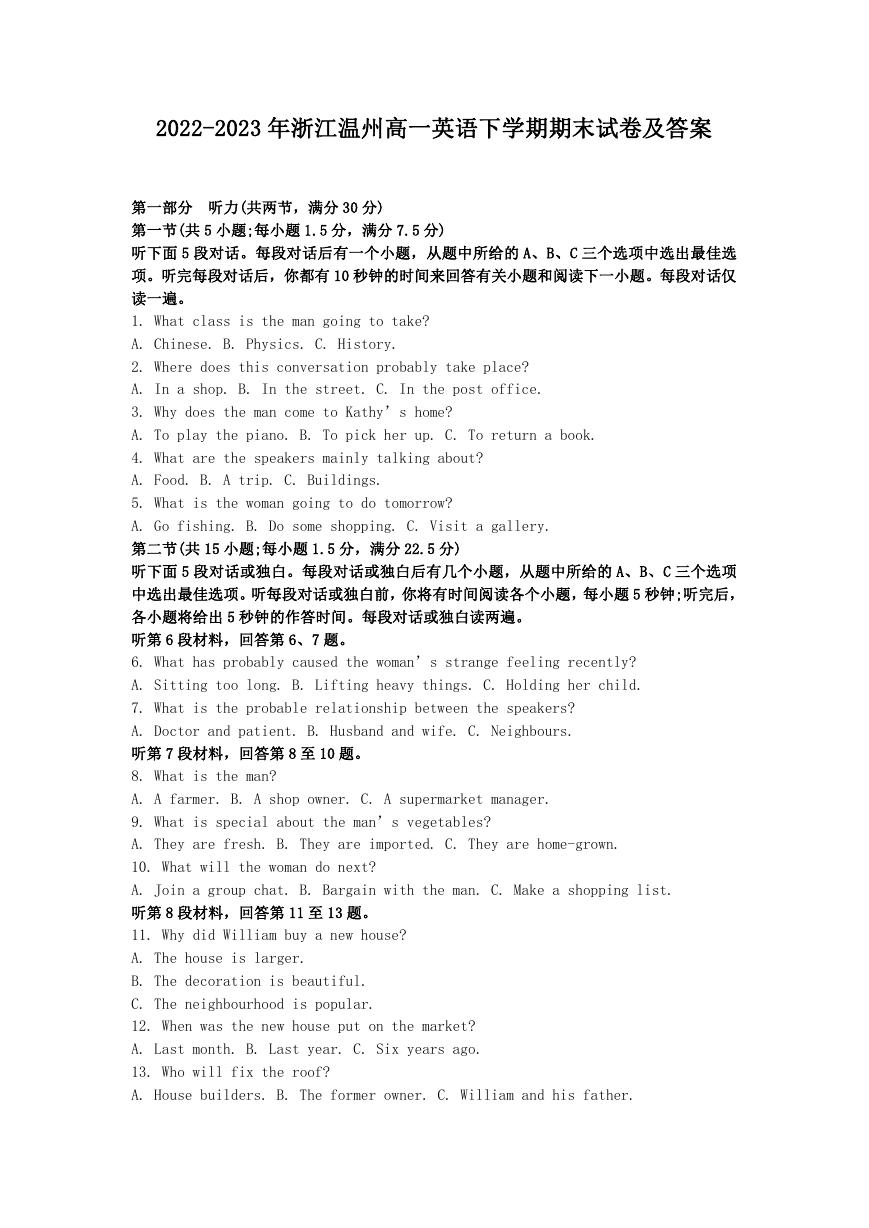
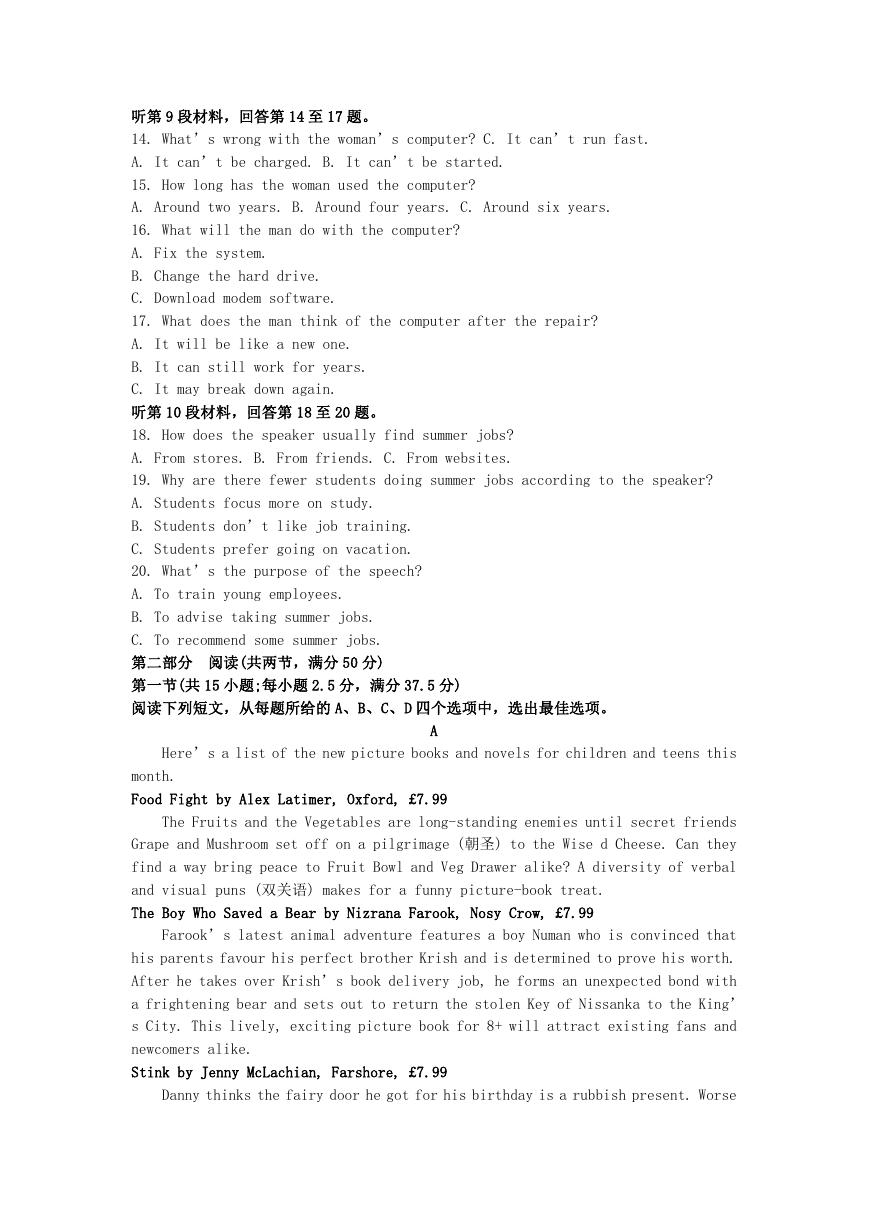
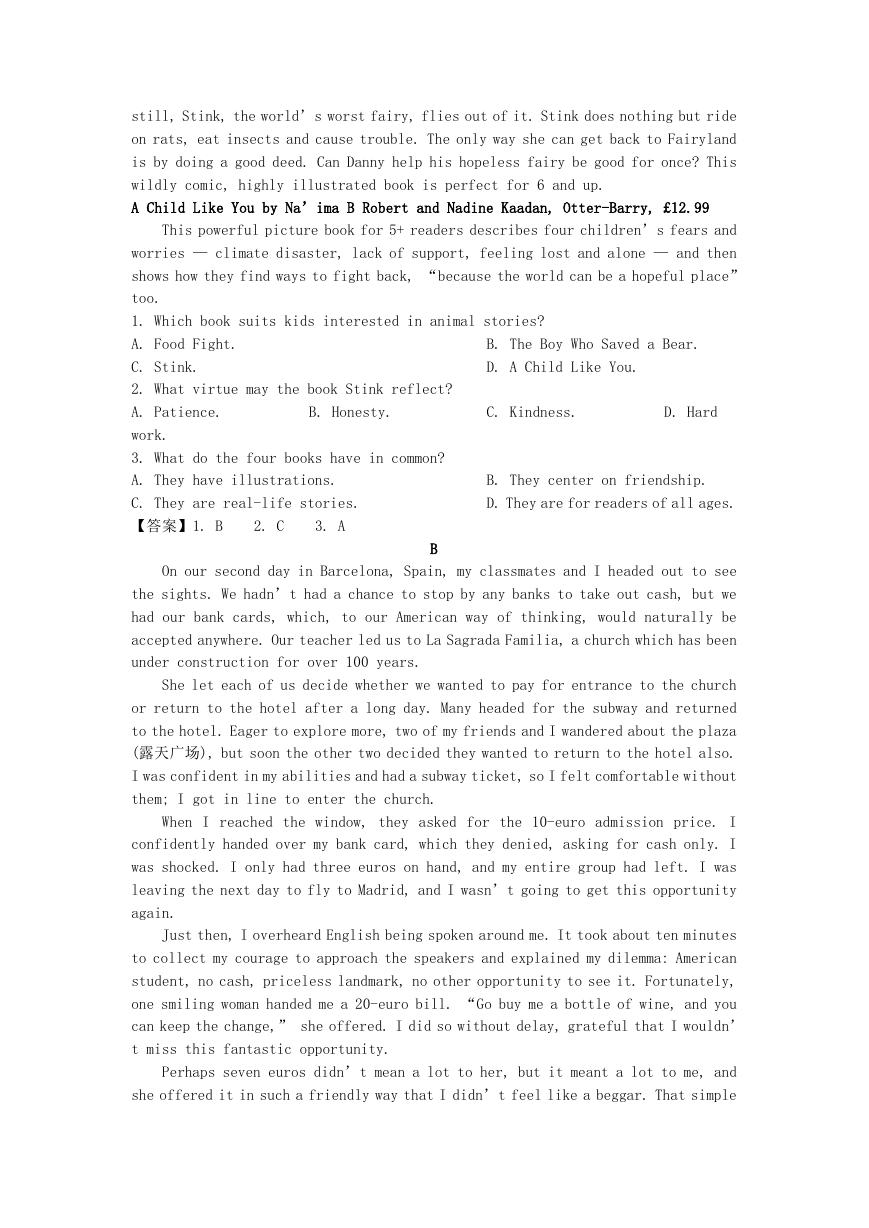
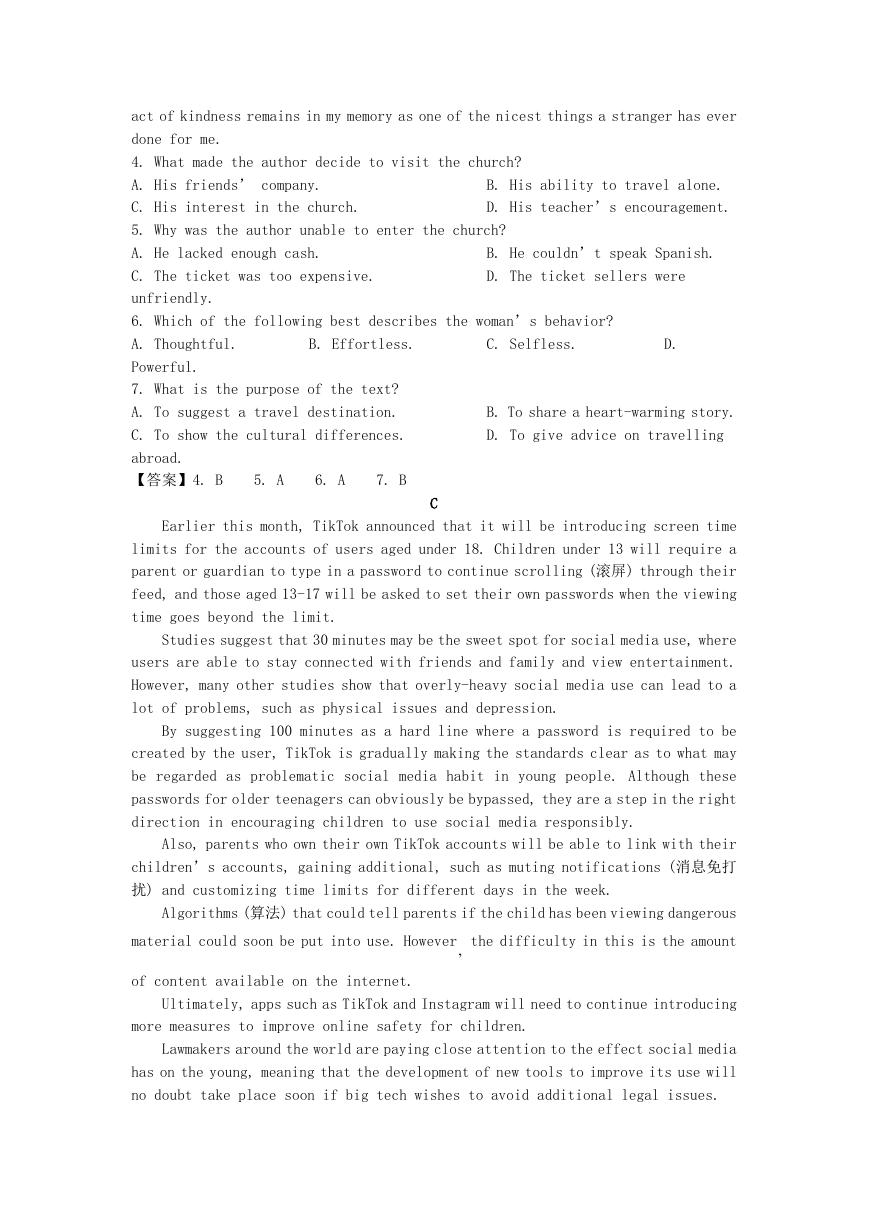
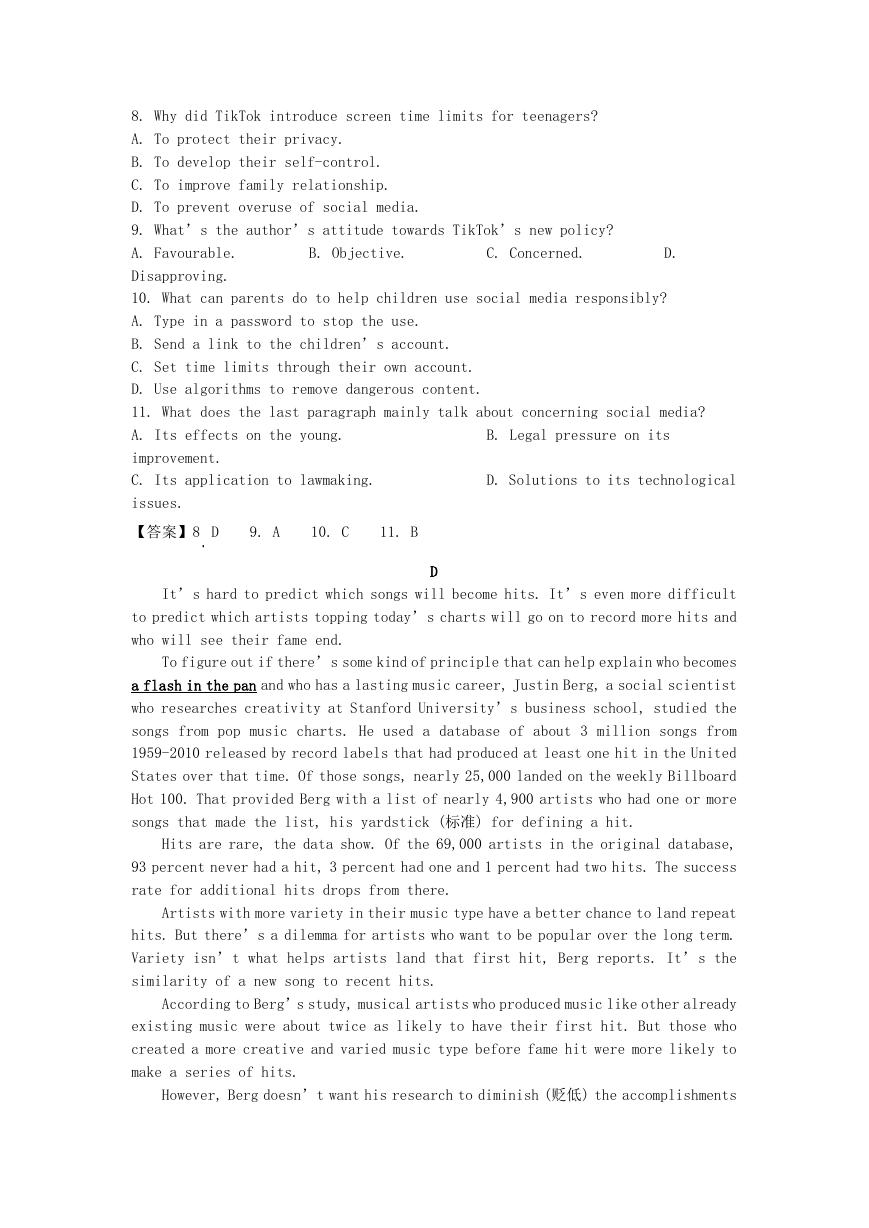
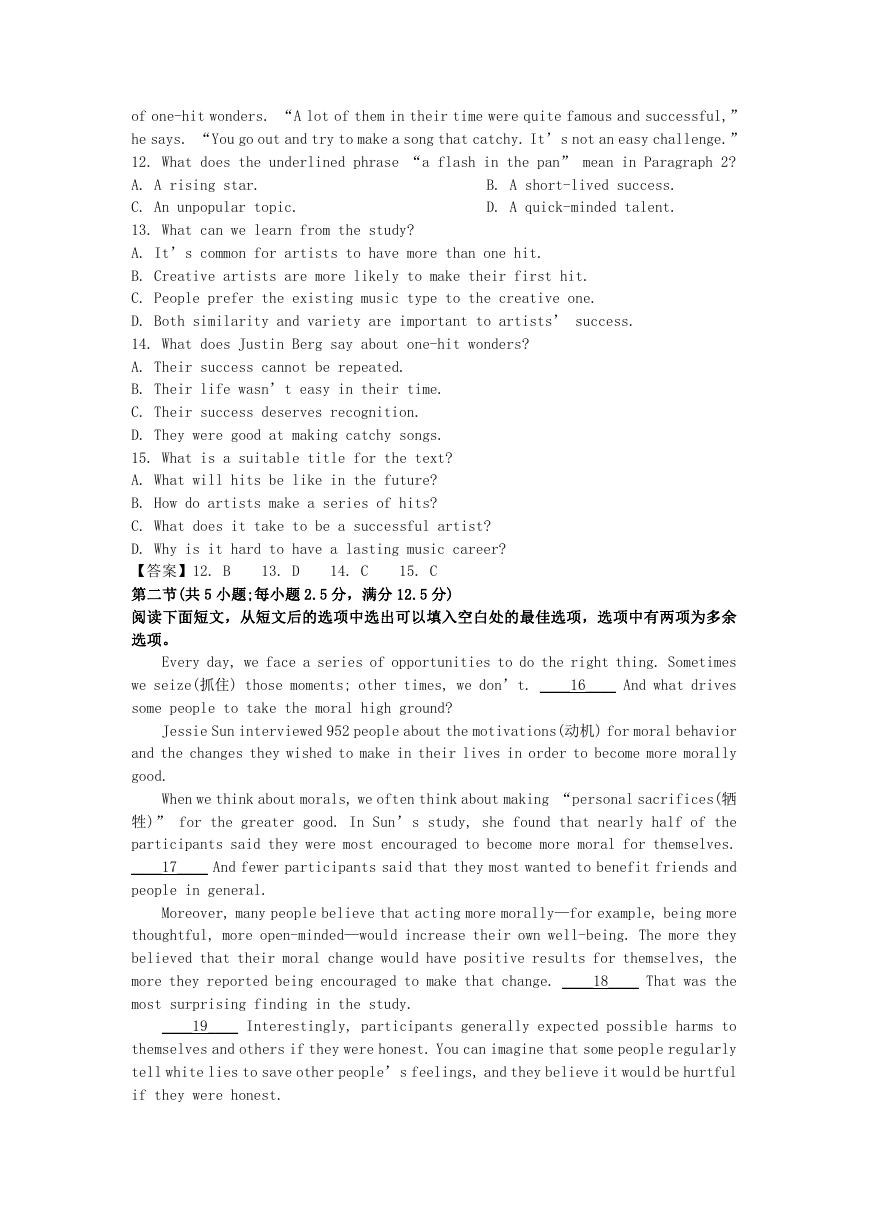
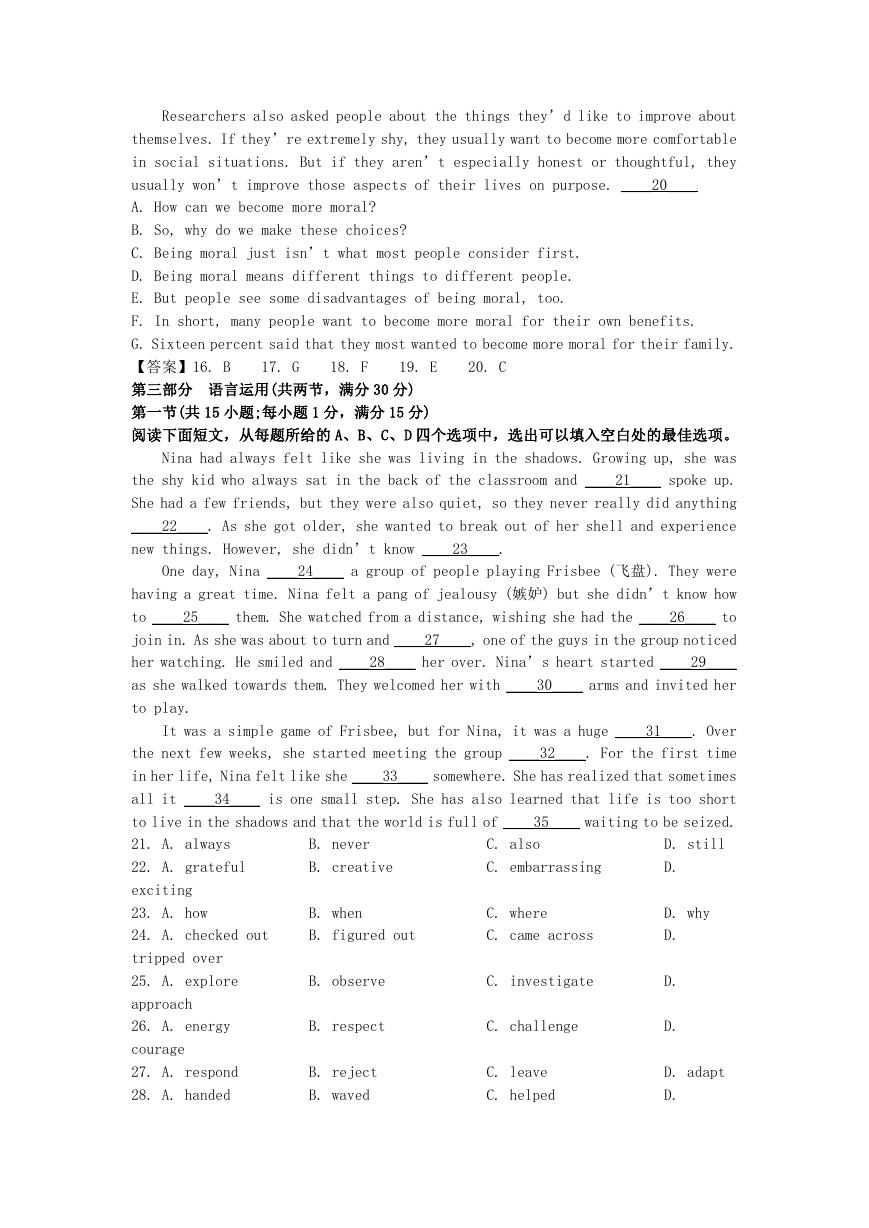









 2023年江西萍乡中考道德与法治真题及答案.doc
2023年江西萍乡中考道德与法治真题及答案.doc 2012年重庆南川中考生物真题及答案.doc
2012年重庆南川中考生物真题及答案.doc 2013年江西师范大学地理学综合及文艺理论基础考研真题.doc
2013年江西师范大学地理学综合及文艺理论基础考研真题.doc 2020年四川甘孜小升初语文真题及答案I卷.doc
2020年四川甘孜小升初语文真题及答案I卷.doc 2020年注册岩土工程师专业基础考试真题及答案.doc
2020年注册岩土工程师专业基础考试真题及答案.doc 2023-2024学年福建省厦门市九年级上学期数学月考试题及答案.doc
2023-2024学年福建省厦门市九年级上学期数学月考试题及答案.doc 2021-2022学年辽宁省沈阳市大东区九年级上学期语文期末试题及答案.doc
2021-2022学年辽宁省沈阳市大东区九年级上学期语文期末试题及答案.doc 2022-2023学年北京东城区初三第一学期物理期末试卷及答案.doc
2022-2023学年北京东城区初三第一学期物理期末试卷及答案.doc 2018上半年江西教师资格初中地理学科知识与教学能力真题及答案.doc
2018上半年江西教师资格初中地理学科知识与教学能力真题及答案.doc 2012年河北国家公务员申论考试真题及答案-省级.doc
2012年河北国家公务员申论考试真题及答案-省级.doc 2020-2021学年江苏省扬州市江都区邵樊片九年级上学期数学第一次质量检测试题及答案.doc
2020-2021学年江苏省扬州市江都区邵樊片九年级上学期数学第一次质量检测试题及答案.doc 2022下半年黑龙江教师资格证中学综合素质真题及答案.doc
2022下半年黑龙江教师资格证中学综合素质真题及答案.doc